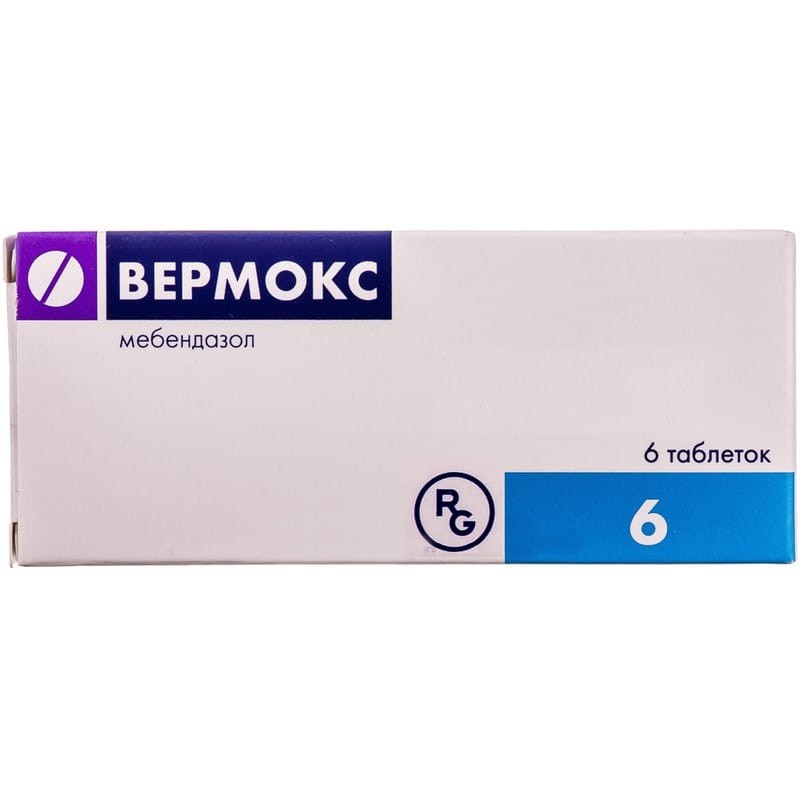



 Secure and encrypted payment processing
Secure and encrypted payment processing We ship to over 40 countries including the USA, UK, Europe, Australia and Japan
We ship to over 40 countries including the USA, UK, Europe, Australia and Japan Guaranteed refund or reship if you haven't received your order
Guaranteed refund or reship if you haven't received your ordermebendazole is an anthelmintic agent with a wide spectrum of action. it is active against enterobius vermicularis, ascaris lumbricioides, trichuris trichiura, ancylostoma duodenale, necator americanus, strongyloides stercoralis, taenia spp. or mixed infestations.
The drug causes degeneration of the helminth cytoplasmic microtubules, thereby inhibiting glucose utilization, reduces energy metabolism and causes the death of the parasite.
Pharmacokinetics After oral administration, mebendazole is absorbed in a small amount in the digestive tract. An insignificant part of it, getting into the blood, binds to blood plasma proteins by 90% and is metabolized in the liver.
Enterobiosis, ascariasis, trichocephalosis, hookworm infection (hookworm disease, necatorosis), strongyloidosis, teniosis, mixed helminthiases.
With enterobiasis, adults and children over the age of 2 years, regardless of body weight and age, are prescribed 1 tablet (100 mg) of Vermox once. due to frequent infections, it is recommended to repeat treatment after 2 and 4 weeks.
In case of ascariasis, trichocephalosis, hookworm infection or mixed helminthiases, adults and children over 2 years old, regardless of body weight and age, are prescribed 1 tablet (100 mg) 2 times a day (1 tablet in the morning and 1 tablet in the evening) for 3 days contract.
In case of teniosis and strongyloidosis for adults - 2 tablets in the morning and in the evening (400 mg / day) for 3 consecutive days; children over the age of 2 years - 1 tablet in the morning and evening (200 mg / day) for 3 consecutive days.
During treatment with Vermox, a special diet or the use of laxatives are not required. Tablets can be chewed or swallowed whole. For young children, the tablet can be crushed before use.
Hypersensitivity (allergy) to any of the components of the drug, the period of pregnancy and lactation.
The list of observed adverse reactions is classified by frequency of occurrence: very often (≥1 / 10), often (≥1 / 100 - 1/10), sometimes (≥1 / 1000 - 1/100), rarely (≥1 / 10,000 - 1/1000), very rarely (1/10 000), unknown (impossible to determine from the available information).
From the blood and lymphatic system: very rarely - neutropenia.
On the part of the immune system: very rarely - hypersensitivity reactions, including anaphylactic and anaphylactoid reactions.
From the side of the central nervous system: very rarely - convulsions, dizziness.
From the digestive tract: often - pain in the lower abdomen; sometimes - abdominal discomfort, diarrhea (with a high degree of infection), flatulence.
On the part of the skin and subcutaneous tissue: sometimes a rash; very rarely - toxic epidermal necrolysis, Stevens-Johnson syndrome, exanthema, angioedema, urticaria, alopecia, pruritus.
Adverse reactions that have been noted with prolonged use of the drug in doses significantly exceeding the recommended:
on the part of the liver and biliary tract: very rarely - impaired liver function, hepatitis;
from the kidneys and urinary tract: unknown - glomerulonephritis.
Each tablet contains 110 mg of lactose monohydrate, therefore, patients with rare hereditary forms of galactose intolerance, lactase deficiency or glucose-galactose malabsorption syndrome should not use the drug.
Research findings indicate a possible association between the use of mebendazole and metronidazole and the occurrence of Stevens-Johnson syndrome / toxic epidermal necrolysis. The simultaneous use of mebendazole and metronidazole should be avoided.
Use during pregnancy and lactation. Since Vermox is contraindicated during pregnancy, pregnant women or if pregnancy is suspected should not be used.
It is not known whether mebendazole passes into breast milk, therefore it is not recommended to breast-feed when using the drug.
Children.It is used to treat children over the age of 2 years. Due to insufficient experience in the use of the drug in children under 2 years of age, and also due to the fact that separate reports have been received about the occurrence of seizures during the use of the drug in children of this age group, Vermox should be prescribed only if the existing helminth infestation seriously affects on their nutritional status and physical development.
The ability to influence the reaction rate when driving vehicles or working with other mechanisms. Mebendazole does not affect the ability to drive vehicles and perform work associated with a high risk of injury, but given the possibility of developing unwanted adverse reactions from the nervous system, special care should be taken.
With the simultaneous administration of cimetidine blocks the metabolism of mebendazole in the liver with a subsequent increase in the concentration of the latter in blood plasma, especially with prolonged treatment. in such cases, concentration measurement is recommended to ensure the necessary doses of both drugs.
The simultaneous use of mebendazole and metronidazole should be avoided (see SPECIAL INSTRUCTIONS).
Alopecia, reversible liver dysfunction, hepatitis, agranulocytosis, neutropenia, and glomerulonephritis were rarely observed in patients taking the drug at doses higher than recommended or treated for a long time. such adverse reactions, with the exception of agranulocytosis and glomerulonephritis, were also detected in patients who used mebendazole in a standard dose (see side effects).
In case of accidental overdose, spastic pain in the lower abdomen, nausea, vomiting, diarrhea can be noted.
Treatment: there is no specific antidote. In the first hour after an overdose, it is necessary to rinse the stomach, take activated charcoal.
At a temperature not exceeding 30 ° C.